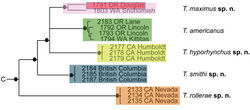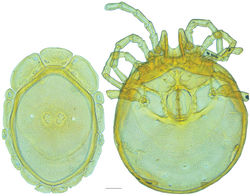Testudacarus kirkwoodae
| Notice: | This page is derived from the original publication listed below, whose author(s) should always be credited. Further contributors may edit and improve the content of this page and, consequently, need to be credited as well (see page history). Any assessment of factual correctness requires a careful review of the original article as well as of subsequent contributions.
If you are uncertain whether your planned contribution is correct or not, we suggest that you use the associated discussion page instead of editing the page directly. This page should be cited as follows (rationale):
Citation formats to copy and paste
BibTeX: @article{O’Neill2016ZooKeys, RIS/ Endnote: TY - JOUR Wikipedia/ Citizendium: <ref name="O’Neill2016ZooKeys">{{Citation See also the citation download page at the journal. |
Ordo: Trombidiformes
Familia: Torrenticolidae
Genus: Testudacarus
Name
Testudacarus kirkwoodae O’Neill & Dowling sp. n. – Wikispecies link – ZooBank link – Pensoft Profile
Type series
Holotype (1♀) Oregon, USA: 1♀ from Douglas County, Rouge River National Forest, Muir Creek, (43°2'53.00"N, 122°21'4.00"W), 12 August 2013, by JC O’Neill and WA Nelson, JNOW13-0812-004 (Specimen 141885 – DNA#1791); Other examined but not measured (1♀): Washington, USA: 1♀ from Snohomish County, Mount Baker National Forest, tributary of South Fork of Sauk River, (48°1'40.00"N, 121°26'24.00"W), 28 July 2013, JC O’Neill and WA Nelson, JNOW13-0728-003
Type deposition
Holotype (1♀) deposited at CNC.
Diagnosis
These are the largest known testudacarines and also differ further from their complex in having a smaller, more rounded anterio-medial platelet.
Description
Female (n=1) with characteristics of genus with following specifications.
Gnathosoma — Subcapitulum [245 ventral length; 133 dorsal length; 130 tall] ovoid with short rostrum. Chelicerae [200 long] unmodified with lightly curved fangs [40 long]. Pedipalp [259 long] unmodified. Trochanter [38 long; 43 wide]. Femur [70 long; 50 wide]. Genu [63 long; 40 wide]. Tibia [63 long; 28 wide]. Tarsus [25 long; 15 wide].
Dorsum (Fig. 35) — [918 long; 645 wide] ovoid to oblong. Dorsal plate [758 long; 566 wide]. Primary sclerotization [603 long] light pink to colorless. Dorso-glandularia-4 [232 apart] lateral to [63] and around muscle scar midline. Platelets colorless. Anterio-medial platelet [201 long; 123 wide]. Anterio-lateral platelets [237 long; 134 wide]. Lateral platelets as follows: lateral-1 [65 long; 55 wide]; lateral-2 [173 long; 46 wide]; lateral-3 [67 long; 24 wide]; lateral-4 [173 long; 46 wide]; lateral-5 [91 long; 47 wide]; lateral-6 [149 long; 54 wide]; lateral-7 [93 long; 46 wide]. Venter (Fig. 35) — [1045 long; 853 wide] round to ovoid and colorless. Primary sclerotization [752 long]. Gnathosomal bay [123 dorsal length; 151 ventral length; 69 wide]. Coxal field [551 long; 484 wide] proportionally small compared to venter. Coxa-I [294 long; 144 midlength]. Coxa-II + III [114 distance to top of coxa-II; 202 distance to top of coxa-III; 393 distance to bottom of coxa-III; 279 total length]. Coxa-IV [376 distance to top; 175 total length]. Genital field [373 distance to top; 578 distance to bottom; 205 total length; 69 width; 222 distance from gnathosomal bay; 78 distance from coxa-I; 272 distance to excretory pore; 467 distance to caudad]. Distance to excretory pore [850].
Legs — colorless. Total leg and podomere lengths as follows: Leg-I [620 total; trochanter 70; basifemur 119; telofemur 89; genu 101; tibia 119; tarsus 121]. Leg-II [681 total; trochanter 77; basifemur 113; telofemur 90; genu 117; tibia 145; tarsus 140]. Leg-III [756 total; trochanter 70; basifemur 116; telofemur 93; genu 144; tibia 165; tarsus 167]. Leg-IV [1081 total; trochanter 136; basifemur 148; telofemur 159; genu 207; tibia 224; tarsus 208].
Male (n=0) unknown.
Etymology
Specific epithet kirkwoodae after my (JCO) mother’s maiden name. It was her bringing me to the leafcutter ant exhibit at our local science center that helped me become interested in biology as a child, and her endless support and advice that helped me finish my education.
Remarks
As it is likely that this species represents a cryptic species complex (with 4.5% COI divergence between the two available specimens), measurements were included from only one specimen (the other highlighted in red in Fig. 32 was excluded). This was done so measurements would remain useful if more species were diagnosed in the future. Measurments were also not included from the other specimen because it is teneral and badly damaged and would therefore prove poor for any description. While more than a single specimen is certainly desired for new descriptions, the included specimen has unique morphological characters such as its large size (it is larger than any other testudacarine, including species from Asia), and has strong support as a unique clade using COI. Therefore, this single specimen is unique enough that we are comfortable describing it.
Distribution
Only one specimen know from Douglas County, Oregon.
Original Description
- O’Neill, J; Fisher, J; Nelson, W; Skvarla, M; Fisher, D; Dowling, A; 2016: Systematics of testudacarine torrent mites (Acari, Hydrachnidia, Torrenticolidae) with descriptions of 13 new species from North America ZooKeys, (582): 13-110. doi
Images
|

